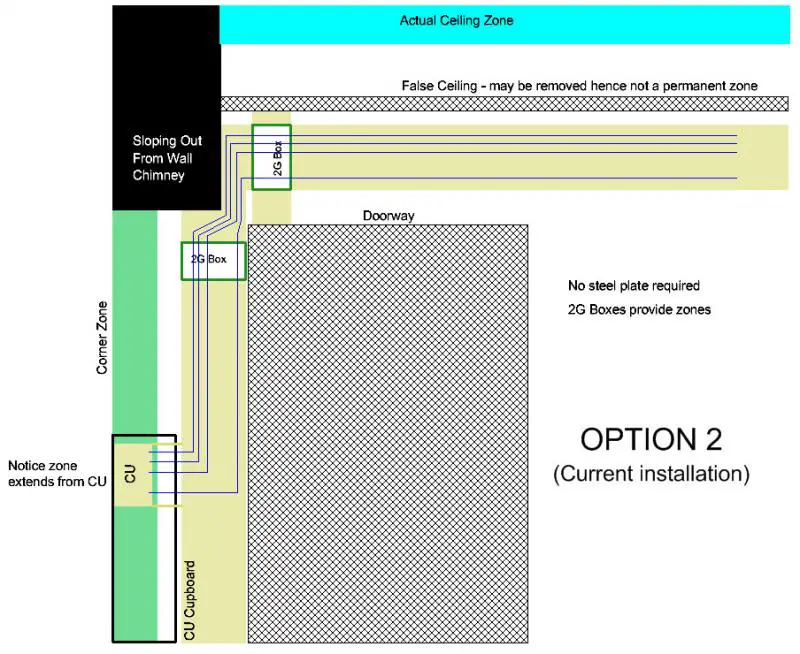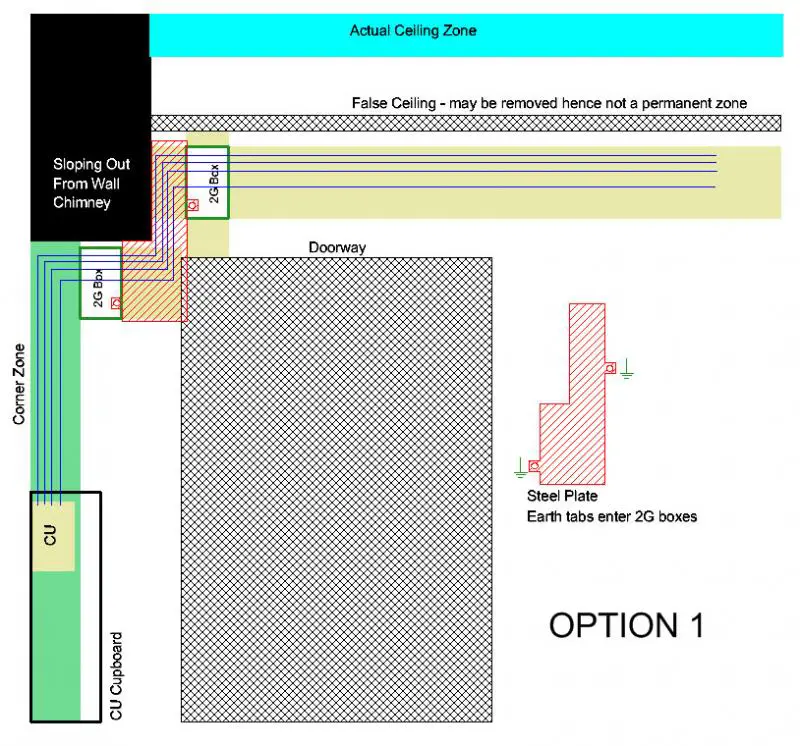Complex room:
- Chimney sloping out of wall in corner of a room
- Corner zone thus ends below ceiling at base of chimney slope
- Ceiling zone thus ends before corner at edge of chimney slope
Current Installation - see Option-2 picture:
- Current 2G boxes are used to mark cable route
- CU zone used to loop cables into big cutout/meter/CU cupboard
The aquapanel-that-was-not separated from the wall, so I have it & tiles off which provides the opportunity to revisit the design. I dislike the proximity to the doorway architrave vs using 150mm corner zone, and the CU being used as a zone to turn into the cupboard. However nothing contravenes regulations - just works them.
Cable bend radius & Cg are ok (4x 2.5mm, 4x 1.5mm at <30% grouped CCC). 4mm 6491X to both boxes BTW.
Alternative - see Option-1 picture:
- Corner zone used
- Steel L-plate for mechanical protection required around sloping chimney
- Steel L-plate earthed by visible & inspectable tabs entering both boxes
- Not enough space for 20mm steel conduit
Sufficient protection against nail or screw penetration (526) could be achieved by lasercut 2-3mm+ stainless plate - highly drill resistant. I recall standard galvanised conduit is 2mm wall, but the standard is buried in a filing cabinet.
Leave it as current (2) or change (1)...?
Cables clipped in flex conduit except around the chimney so an easy change.
The question is whether no or little perceived improvement.
- Chimney sloping out of wall in corner of a room
- Corner zone thus ends below ceiling at base of chimney slope
- Ceiling zone thus ends before corner at edge of chimney slope
Current Installation - see Option-2 picture:
- Current 2G boxes are used to mark cable route
- CU zone used to loop cables into big cutout/meter/CU cupboard
The aquapanel-that-was-not separated from the wall, so I have it & tiles off which provides the opportunity to revisit the design. I dislike the proximity to the doorway architrave vs using 150mm corner zone, and the CU being used as a zone to turn into the cupboard. However nothing contravenes regulations - just works them.
Cable bend radius & Cg are ok (4x 2.5mm, 4x 1.5mm at <30% grouped CCC). 4mm 6491X to both boxes BTW.
Alternative - see Option-1 picture:
- Corner zone used
- Steel L-plate for mechanical protection required around sloping chimney
- Steel L-plate earthed by visible & inspectable tabs entering both boxes
- Not enough space for 20mm steel conduit
Sufficient protection against nail or screw penetration (526) could be achieved by lasercut 2-3mm+ stainless plate - highly drill resistant. I recall standard galvanised conduit is 2mm wall, but the standard is buried in a filing cabinet.
Leave it as current (2) or change (1)...?
Cables clipped in flex conduit except around the chimney so an easy change.
The question is whether no or little perceived improvement.




